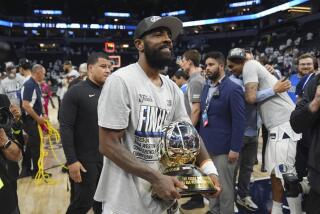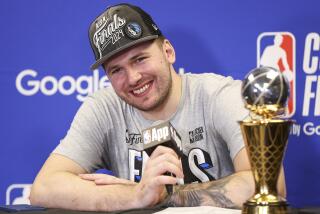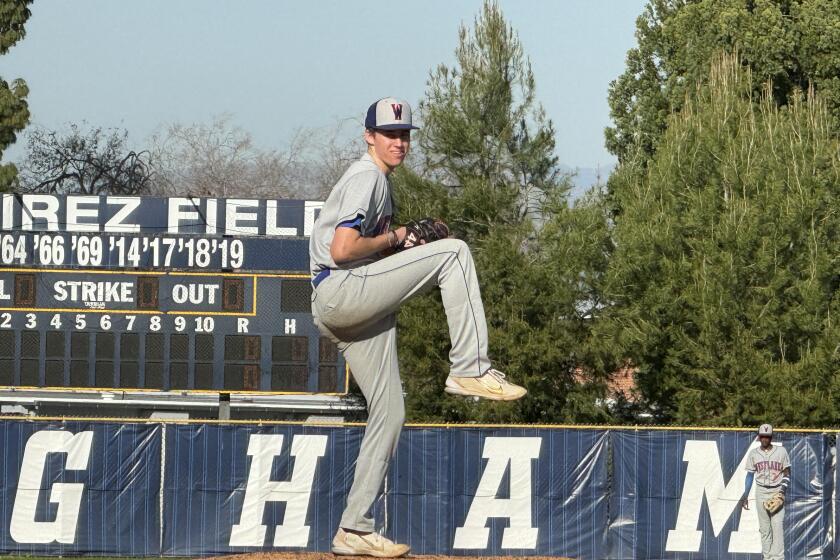A MEGA-STAR IS BORN
- Share via
DALLAS — Check out the NBA’s final top 10 scorers and rebounders, and only one name is found on both lists: Dirk Nowitzki.
Scan the winners of the Western Conference’s player of the month award, and he’s the only person honored twice. Then look at the standings and see that his Dallas Mavericks have racked up another 50-win season and home court in the first round of the playoffs.
Now factor in some of the other status symbols that have come Nowitzki’s way lately -- getting Punk’d by MTV, playing advice columnist on NBA.com and doing such a good job on humorous league TV commercials that he’ll soon be appearing in his third one.
It all adds up to one conclusion: At 26, and in his seventh season since arriving from Germany with a new-wave haircut and unlimited potential, Nowitzki is taking the final step from star to superstar, and inching closer to the stratosphere of the league’s best power forwards, two-time MVP Tim Duncan and last year’s MVP, Kevin Garnett.
Nowitzki scored a career-best 2,016 this season as the Mavericks finished the regular season with eight straight wins and had recorded wins in 15 of 17 games since Avery Johnson replaced Don Nelson as coach last month. The win also gave Dallas a nine-game home winning streak to take into the playoffs. The Mavericks host the Houston Rockets in the first round.
To truly appreciate Nowitzki’s rise, you must understand the circumstances. What’s turned out to be his best season could have been his worst, considering he’s without two of the most instrumental figures in his development, point guard and close pal Steve Nash and Nelson, who until last month was Nowitzki’s only NBA coach.
“He just keeps working to get better,” Nash said. “He’s more confident, more experienced and has a better feel for the game. Maybe some of it is because the team changed and he had to take on more responsibility, but I think overall it’s just a natural progression.”
Nash and Nowitzki were acquired in separate deals on draft day in 1998. They met in Dallas a few days later and quickly became close friends. Their bond on the court made Nash-to-Nowitzki almost as automatic as Stockton-to-Malone.
Then, last summer, Nash signed as a free agent with Phoenix, leaving his buddy behind to create his own shots for the first time in the NBA.
When Nash called with the news, Nowitzki was back home in Germany, working as he does every offseason with his personal coach-mentor, Holger Geschwindner. Coincidentally, they already had been focusing on his one-on-one game.
“I knew once Steve left that I’d have to work harder on everything,” Nowitzki said. “Steve was so good at getting me open at all times. I knew it wasn’t going to be that way any more, that I was going to have to make stuff happen off the dribble.”
He proved he could from the start, putting up 33 points, 10 rebounds and five assists in the opener and leading the Mavs to seven wins in the first eight games. Then he opened December by scoring 53 points -- a career high, franchise record and the most ever by a foreign player -- and finished the month as the conference’s top player. He was picked again in February.
A 7-footer with endless range, Nowitzki’s big change has been relying less on his jumper. He’s posting up more and looking to drive whenever possible, plus using a great fake move that defenders fall for even when they’re expecting it. As a result, he’s replaced the easy shots Nash used to get him with another gimme -- free throws.
An 86 percent career foul shooter, Nowitzki went into this weekend second in the league in made free throws and fifth in attempts. Better yet, as of April 1 he’d already made more free throws than he’d ever attempted in a season.
His new mind-set stretches beyond the three-point line. He’s taking just three per game, down from 4.3 the last five seasons, but making a career-best 40 percent.
“Am I surprised? Probably not,” Nowitzki said. “I really worked hard in the offseason.”
Nowitzki was considered one of the toughest players to guard before his transformation. Now he’s made it even more difficult.
“Used to be you’d rather him do this or that. Now, I don’t know what it is,” Rudy Tomjanovich said in January, when he was still coaching the Lakers and they were about to face Nowitzki.
After seeing Nowitzki get 41 points and 10 rebounds against his team in November, Miami Coach Stan Van Gundy was left with a defeatist’s strategy for their February rematch.
“Hope he misses,” Van Gundy said.
Nelson knew Nowitzki was a walking mismatch from the first time he saw him, which is why he gambled on someone who’d only played in German club leagues and some international juniors tournaments.
By his third season, Nowitzki had blossomed into the team’s leading scorer and Dallas was in the playoffs for the first time in 11 years. The Mavs have been playoff regulars ever since, reaching the conference finals in 2003.
They tried a new formula last season, adding Antoine Walker and Antawn Jamison to try outscoring everyone. It didn’t work, partly because Nowitzki got the ball less. So Dallas reverted to a conventional alignment this season, with Nowitzki featured on offense and Johnson brought in as an assistant coach preaching defense.
Johnson became Nelson’s successor last month. His impact on Nowitzki has been as profound as the rise in free throws.
With Johnson urging him to use his hands and feet more, Nowitzki has become a respectable one-on-one defender and a reliable second line of defense inside when teammates are beaten on the perimeter. Not only has he shed the mocking label of “Irk” -- as in Dirk with no D -- but Mavs’ owner Mark Cuban calls him one of the team’s top stoppers.
The Portland Trail Blazers might agree, especially after Nowitzki blocked two shots and made a steal in the final minute of a January game, turning a one-point Dallas lead into a seven-point win. Just this week, Nowitzki frustrated Memphis’ Pau Gasol into going five for 15 and repeatedly poked the ball away on spins to the basket.
“I think he’s paying attention to detail defensively,” Johnson said. “He’s not as easy a guy to score on.”
Something else Johnson has done that Nelson struggled with is reducing Nowitzki’s minutes. Nowitzki grudgingly admits that playing less has made him fresher in the fourth quarter.
The added bench time has led to another benefit. Cuban says Nowitzki has become the team’s top cheerleader, often the first one up to celebrate a shot or greet teammates during timeouts.
Now that the playoffs have started, Nowitzki won’t be sitting much. Odds are, he’ll take even more of a starring role.
In his four postseasons, Nowitzki’s scoring average always has exceeded his regular-season total. His rebounding numbers have spiked the last three years.
According to Geschwindner, Nowitzki is at least two years from peaking -- or, as the guru calls it, “filling his toolbox.” Their to-do list includes refining his dribbling and passing, perfecting his hook shot and improving anticipation on defense, along with tasks such as beating double teams and reining in teammates when things are getting out of control.
“Dirk wants to achieve certain goals and he’s doing everything he wants,” Geschwindner said during a recent visit to Dallas. “But we must wait until a wonder woman comes around. Then it might change a little.”
Chuckling, he continued: “But we are waiting. There’s no hurry.”
More to Read
Go beyond the scoreboard
Get the latest on L.A.'s teams in the daily Sports Report newsletter.
You may occasionally receive promotional content from the Los Angeles Times.










